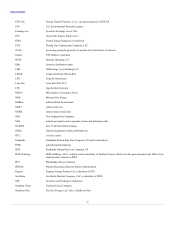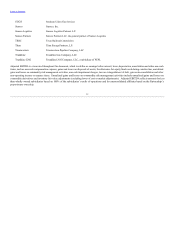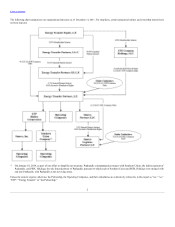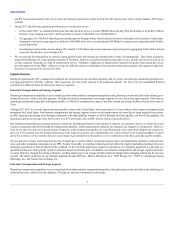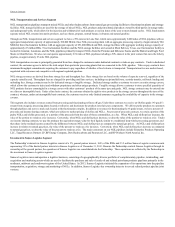Energy Transfer 2013 Annual Report Download - page 13
Download and view the complete annual report
Please find page 13 of the 2013 Energy Transfer annual report below. You can navigate through the pages in the report by either clicking on the pages listed below, or by using the keyword search tool below to find specific information within the annual report.
Table of Contents
of natural gas, less the costs of transportation. For the off-system gas, we purchase gas or act as an agent for small independent producers that may not
have marketing operations.
Asset Overview
Intrastate Transportation and Storage
The following details our pipelines and storage facilities in the intrastate transportation and storage segment.
ET Fuel System
•Capacity of 5.2 Bcf/d
•Approximately 2,870 miles of natural gas pipeline
•Two storage facilities with 12.4 Bcf of total working gas capacity
•Bi-directional capabilities
The ET Fuel System serves some of the most prolific production areas in the United States and is comprised of intrastate natural gas pipeline and related
natural gas storage facilities. The ET Fuel System has many interconnections with pipelines providing direct access to power plants, other intrastate, and
interstate pipelines and is strategically located near high-growth production areas and provides access to the Waha Hub near Midland, Texas, the Katy Hub
near Houston, Texas and the Carthage Hub in East Texas, the three major natural gas trading centers in Texas.
The ET Fuel System also includes our Bethel natural gas storage facility, with a working capacity of 6.4 Bcf, an average withdrawal capacity of 300 MMcf/d
and an injection capacity of 75 MMcf/d, and our Bryson natural gas storage facility, with a working capacity of 6.0 Bcf, an average withdrawal capacity of
120 MMcf/d and an average injection capacity of 96 MMcf/d. All of our storage capacity on the ET Fuel System is contracted to third parties under fee-based
arrangements that extend through 2015.
In addition, the ET Fuel System is integrated with our Godley processing plant which gives us the ability to bypass the plant when processing margins are
unfavorable by blending the untreated natural gas from the North Texas System with natural gas on the ET Fuel System while continuing to meet pipeline
quality specifications.
Oasis Pipeline
•Capacity of 1.2 Bcf/d
•Approximately 600 miles of natural gas pipeline
•Connects Waha to Katy market hubs
•Bi-directional capabilities
The Oasis pipeline is primarily a 36-inch natural gas pipeline. It has bi-directional capability with approximately 1.2 Bcf/d of throughput capacity moving
west-to-east and greater than 750 MMcf/d of throughput capacity moving east-to-west. The Oasis pipeline has many interconnections with other pipelines,
power plants, processing facilities, municipalities and producers.
The Oasis pipeline is integrated with our Southeast Texas System and is an important component to maximizing our Southeast Texas System’s profitability.
The Oasis pipeline enhances the Southeast Texas System by (i) providing access for natural gas on the Southeast Texas System to other third party supply
and market points and interconnecting pipelines and (ii) allowing us to bypass our processing plants and treating facilities on the Southeast Texas System
when processing margins are unfavorable by blending untreated natural gas from the Southeast Texas System with gas on the Oasis pipeline while continuing
to meet pipeline quality specifications.
HPL System
•Capacity of 5.3 Bcf/d
•Approximately 3,900 miles of natural gas pipeline
•Bammel storage facility with 62 Bcf of total working gas capacity
The HPL System is an extensive network of intrastate natural gas pipelines, an underground Bammel storage reservoir and related transportation assets. The
system has access to multiple sources of historically significant natural gas supply reserves from South Texas, the Gulf Coast of Texas, East Texas and the
western Gulf of Mexico, and is directly connected to major gas distribution, electric and industrial load centers in Houston, Corpus Christi, Texas City and
other cities located along the Gulf Coast of Texas. The HPL System is well situated to gather and transport gas in many of the major gas producing areas in
Texas including the strong presence in the key Houston Ship Channel and Katy Hub markets, allowing us to play an important role in the Texas natural gas
markets. The HPL System also offers its shippers off-system opportunities due to its numerous interconnections with other
8



